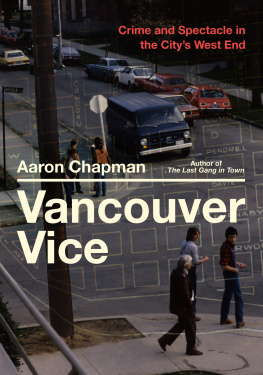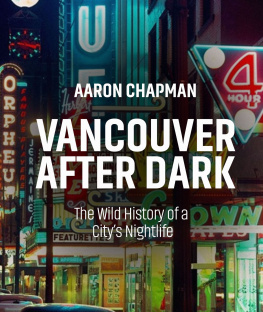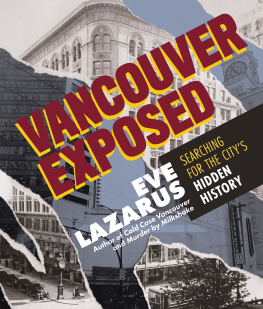Contents
Page List
Guide
Vancouver Vice
Vancouver Vice
Crime and Spectacle in the Citys West End
Aaron Chapman
VANCOUVER VICE
Copyright 2021 by Aaron Chapman
All rights reserved. No part of this book may be reproduced in any part by any meansgraphic, electronic, or mechanicalwithout the prior written permission of the publisher, except by a reviewer, who may use brief excerpts in a review, or in the case of photocopying in Canada, a licence from Access Copyright.
ARSENAL PULP PRESS
Suite 202 211 East Georgia St.
Vancouver, BC V6A 1Z6
Canada
arsenalpulp.com
The publisher gratefully acknowledges the support of the Canada Council for the Arts and the British Columbia Arts Council for its publishing program, and the Government of Canada, and the Government of British Columbia (through the Book Publishing Tax Credit Program), for its publishing activities.
Arsenal Pulp Press acknowledges the xmkym (Musqueam), Swxw7mesh (Squamish), and slilwta (Tsleil-Waututh) Nations, custodians of the traditional, ancestral, and unceded territories where our office is located. We pay respect to their histories, traditions, and continuous living cultures and commit to accountability, respectful relations, and friendship.
Efforts have been made to locate copyright holders of source material wherever possible. The publisher welcomes correspondence from any copyright holders of material used in this book who have not been contacted.
Cover design by Jazmin Welch
Front cover image: CROWE Archives c/o Gordon Price
Back cover images (top to bottom): Vancouver Sun, February 17, 1961, 1; Glenn Baglo, Vancouver Sun, 1977, c/o Vancouver Sun Archives; Ian Lindsay, Vancouver Sun, 1984, c/o Vancouver Sun Archives; CROWE Archives c/o Gordon Price
Text design by Electra Design Group
Edited by Derek Fairbridge
Copyedited by Shirarose Wilensky
Proofread by Alison Strobel
Indexed by Catharine Chen
Printed and bound in Canada
Library and Archives Canada Cataloguing Publication:
Title: Vancouver vice : crime and spectacle in the citys West End / Aaron Chapman.
Names: Chapman, Aaron, 1971 author.
Description: Includes bibliographical references and index.
Identifiers: Canadiana (print) 20210226404 | Canadiana (ebook) 20210226455 | ISBN 9781551528694 (softcover) | ISBN 9781551528700 (HTML)
Subjects: LCSH: West End (Vancouver, B.C.) | LCSH: CrimeBritish ColumbiaVancouverHistory20th century. | LCSH: Vice controlBritish ColumbiaVancouverHistory20th century. | LCSH: West End (Vancouver, B.C.)Social conditions20th century. | LCSH: West End (Vancouver, B.C.)History20th century.
Classification: LCC HV6810.V3 C43 2021 | DDC 364.9711/33dc23
Contents
Lost Lagoon in 2021.
Photo by Christopher Edmonstone 2021
PROLOGUE
Murder at Lost Lagoon
I t was just before seven oclock on the evening of Wednesday, May 2, 1984, when police and ambulance first arrived on a quiet, tree-lined stretch of road along the north side of Lost Lagoon in Vancouvers Stanley Park.
The weather forecast had predicted partly cloudy with a few showers, but so far the rain had held off. And even though North Lagoon Drive was shaded by a tall canopy of trees, with the forest of the great urban park behind it, there was still plenty of evening light. The late-spring sun wouldnt set for another hour or so.
A report of a suspected homicide had come from the Vancouver Police Department (VPD) communications centre at 312 Main Street. Details were sparse in the initial radio dispatch: Two men at the scene reported finding an abandoned car, a vehicle they said they recognized. They reported that the driver was missing. No mention of a body. It was unclear at the time how they knew the vehicle or the driver. Later, the police considered the possibility that the two had been trying to break into the car when they discovered a body in the trunk and had fabricated the story to cover their tracks. Even innocent people can make up an alibi when they get nervous and find themselves in the wrong place, at the wrong time.
As police from around downtown responded to reports of the abandoned car, some made derisive or even homophobic wisecracks that, given the proximity to the gay cruising areas along Stanley Parks Lees Trail, the driver would likely be back shortly with a pair of muddy knees, wondering why all the police had shown up. But when the details emerged that a body had been found in the trunk of the car, the joking stopped.
Police humour is a particularly dark brand of levity that others, who dont regularly deal with dead bodies, can often find macabre, or just plain insensitive. But police, firefighters, and paramedics often share this sardonic point of view among themselves as a coping mechanism to help them weather the often unrelenting stress of their jobsespecially if theyve done the job for years. Even so, hardened veterans become solemn and put aside flippant jokes when they walk into a homicide scene in an area as public as Stanley Parkespecially when there is a possibility that more than one victim might be discovered.
The car had been parked on a lay-by big enough for a vehicle to stop for a short time without interrupting traffic on the two-lane North Lagoon Drive. Trees and brush along the roadside gave the spot enough shade and cover to make it difficult to see who or what had parked there when viewed from the south side of the lagoon.
Ambulance attendants David Morris and Wayne Banks viewed the body upon arrival but did not disturb it. Two patrol constables, Les Yeo and Ray Winters, the first police to arrive, set up a perimeter to preserve the crime scene. They were followed by detectives Fred Johns and Ken Larkie from the VPDs Major Crime Section.
Any time a homicide is reported over police dispatch, it is always met with a significant initial response. Ambulance and homicide investigators arrive, but there are a host of others who report to such scenespathologists, forensics, a body disposal crew. Available uniformed patrol officers in the area also provide support, if for nothing more than crowd control when the crime scene is in a public place. On this particular call, a retinue of department officials arrived at Lost Lagoon, as well as some who, years later, would become well-known names in the Lower Mainland. Coroner Larry Campbellmayor of Vancouver from 2002 to 2005 and inspiration for the TV series Da Vincis Inquestwas present, as was a young District One patrol officer, Constable Bob Rich, just four years into his law enforcement career, who would become chief constable of the neighbouring city of Abbotsford in 2008. District One spread from Beatty Street, along the southeastern edge of downtown, to the end of Stanley Park, and included all of the West End and much of downtown but not the Downtown Eastside. District patrol supervisors Sergeant Brian Honeybourn and Corporal Phil Potts arrived on the Lost Lagoon scene, as did VPD fingerprint expert Sergeant Joe Mikita from the forensic identification unit to collect evidence.













